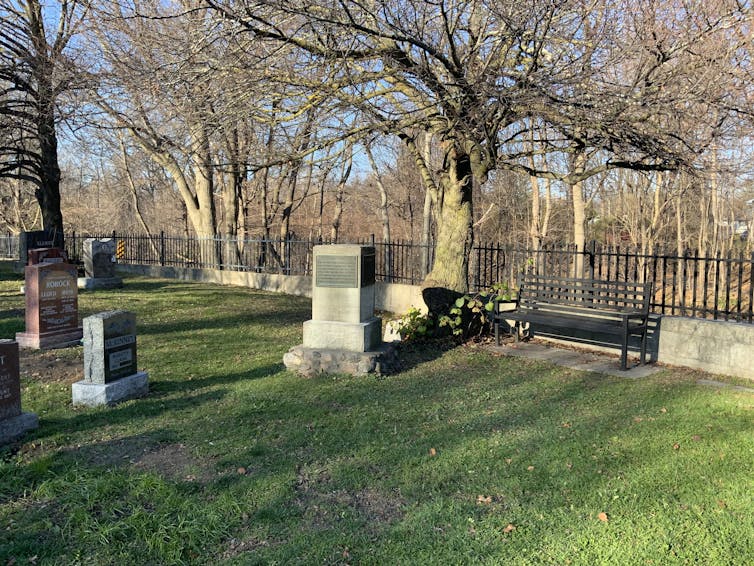Canada News
Suburban monumentalism: How do we change Indigenous-settler relations when there are no statues to destroy?
Across Canada’s cities, protesters have defaced statues and monuments to help rewrite Indigenous-settler relations.
Powerful messages overlay the destruction: red handprints, “clean water-land back,” “we were children,” “respect the treaties” and “215.”
Read more: Amid more shocking residential schools discoveries, non-Indigenous people must take action
But the suburbs have escaped this political reckoning for a mix of reasons. They’ve been written into our imagination as an empty land without history ready to be occupied and manicured. For more than a century, city-dwellers have been escaping the chaos of the city for the burbs.
Our understanding of the suburbs as a place without history is a violent fiction of settler-colonialism. We suggest the term suburban monumentalism to explain how the suburban-built environment contributes to Indigenous dispossession and settler-colonial violence.
Suburban monumentalism is an oxymoron. Unlike its urban cousin, suburban monumentalism does not occupy remarkable public spaces. As a result, it flies under the radar of political confrontation.
Read more: Canada needs to reckon with the relics of its colonial past, including racist statues
Absent statues and public squares, suburban monumentalism weaves stories of ordinary settler families into the landscape. It erases Indigenous peoples from the land. Streets, subdivisions, schools and baseball fields carry the names of “founding” settler families. Church museums, cemeteries and historical plaques celebrate the ingenuity and industry of the settler.
In this quaint and barely noticeable form, the suburbs build on the cultural narrative of escape from urban chaos to erect a built environment that celebrates Indigenous dispossession. Occupying space alongside cookie cutter subdivisions and megamalls, suburban monumentalism is just bland enough to escape scrutiny.
Scarborough’s suburban monumentalism
Scarborough, a bustling suburban region of Toronto, has key features of suburban monumentalism. Scarborough has been a site of settlement, migration and crossing for thousands of years. It has been a disputed territory for at least 200 years as Indigenous peoples have challenged settlement on unceded land and the duplicity of the treaty process. Indigenous people continue to live and shape the area, as well as fight for return of the land.
All of this complexity and contentious political history is largely absent from Scarborough’s monuments and built environment.
Scarborough’s naming conventions weave a settler-origin story into the land. The Thomson family appears in the naming of David and Mary Thomson Collegiate, Thomson Memorial Park and in the collections of the Scarborough Historical Museum.

Historical plaques erase Indigenous histories and presence on the land. A plaque in Scarborough’s St. Andrew’s Presbyterian Church cemetery reads:
“West of this point passed an Indian Trail leading to prehistoric Indian villages of which traces have been found. This was the Trail by which David Thomson, the first white settler in Scarborough, came to the site upon which he built his house in 1796.”
The plaque refers to an “old Indian road,” illustrating the myth of the Thomson family discovering and settling a largely uninhabited space. In Scarborough, the settler account suggests that Indigenous presence only leaves traces.
Read more: Why activists are vandalizing statues to colonialism
The erasure of Indigenous people and the violation of treaty relations is naturalized through repetition. Every year, scores of school kids visit the Scarborough Museum and learn about the Thomsons building their first cabin and celebrating how hardy they were.
These stories and the nondescript plaques that accompany them are instructive. They instil views about land and history. And in such stories, Indigenous peoples remain unnamed, invisible or assumed not present while settlers’ names are woven into the suburban landscape as a natural presence.

Suburban monumentalism also celebrates settler’s taming nature through work, perseverance and industry. A plaque located along Highland Creek by a dog park at the University of Toronto’s Scarborough campus describes the succession of mills that flourished on the creek in the 1840s. It reads: “The early settlers of Scarborough used the waters of Highland Creek to provide power for their many saw and grist mills …”
There was careful planning regarding the language used and plaque placement. The plaque holds the authority of history and the detail on the plaque encourages the passing onlooker to not question its veracity.
Suburban truth-work for re/conciliation
Surburban monumentalism is present across Canada’s cities. It replicates this bland account of our history through naming conventions, barely noticeable landmarks and a common man approach to the public record. In each case the narratives erase Indigenous presence from the land, replace it with settler-colonial foundations and simplify Indigenous-settler relations.
The practice is never accidental, it is a purposeful and political act refashioned as our shared history. We need to recognize that the work of rewriting the settler-colonial violence of the suburbs will take political awakening, a lot of dialogue and maybe a little vandalism.
Patricia Landolt, Professor of Sociology, University of Toronto and Paloma E. Villegas, Assistant Professor, Sociology, California State University San Bernardino
This article is republished from The Conversation under a Creative Commons license. Read the original article.





















